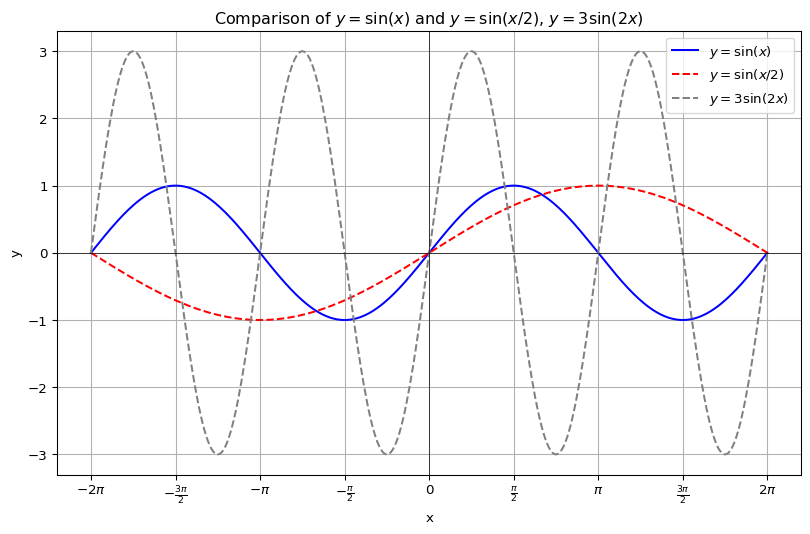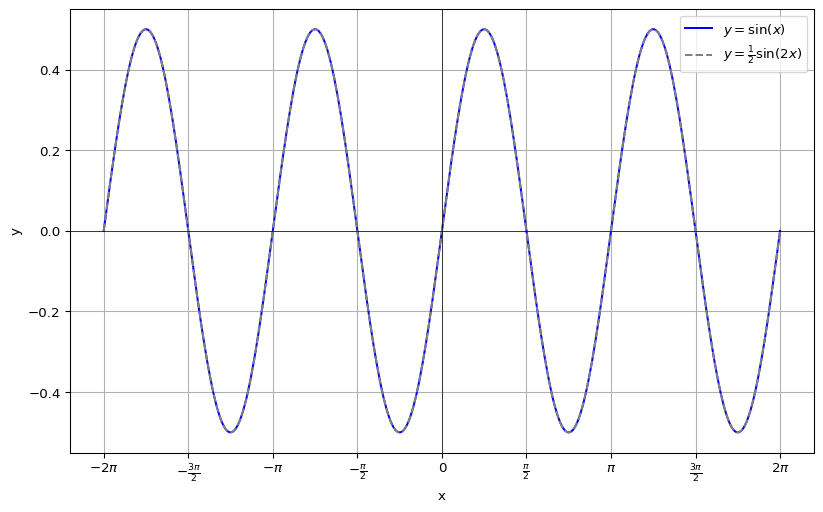加法定理
Theorem 1
\[
\begin{align}
\sin (\alpha + \beta) &= \sin \alpha \cos \beta + \cos \alpha \sin \beta\\
\cos (\alpha + \beta) &= \cos \alpha \cos \beta - \sin \alpha \sin \beta
\end{align}
\]
「咲いたコスモス,コスモス咲いた」なり「しこってこすってこすってしこって」と語呂合わせで加法定理を覚えたりしますが,ここでは加法定理を図形的に考えてみたいと思います.
Figure 1 のように半径 \(1\) の単位円周上に \(\angle DOB = \alpha + \beta\) となる点 \(B\) をとります. 同じく \(\angle AOD = \alpha\) となるように点をとると,\(\angle BOA = \beta\) となります.このとき,点 \(B\) の \(y\) 成分は \(\sin(\alpha + \beta)\) となります.
点 \(B\) から直線 \(OA\) 上に垂線を下ろし,その交点を \(C\) とすると \(OB = 1\) より
\[
\begin{align}
BC & = \sin\beta\\
OC &= \cos\beta
\end{align}
\]
となることがわかります.点 \(C\) から垂線を下ろし,\(x\) 軸との交点を \(E\) , \(B\) から直線 \(CE\) との交点を \(F\) とすると
\[
\begin{align}
CE &= \sin \alpha\cos\beta\\
CF &= \cos\alpha\sin\beta
\end{align}
\]
したがって,\(CE + CF = \sin(\alpha + \beta)\) となることから
\[
\sin (\alpha + \beta) = \sin \alpha \cos \beta + \cos \alpha \sin \beta
\]
となることが図形的にわかります.同様に
\[
\begin{align}
OE &= \cos\alpha\cos\beta\\
BF&= \sin\alpha\sin\beta
\end{align}
\]
より
\[
\cos(\alpha + \beta) = OE - BF = \cos\alpha\cos\beta - \sin\alpha\sin\beta
\]
▶ 2角の差 \(\alpha - \beta\) の場合
\(\sin(-\beta) = -\sin(\beta)\) および \(\cos(-\beta) = \cos\beta\) より
\[
\begin{align}
\sin (\alpha - \beta)
&= \sin (\alpha + (-\beta))\\
&= \sin \alpha \cos (-\beta) + \cos \alpha \sin (-\beta)\\
&= \sin \alpha \cos \beta - \cos \alpha \sin \beta
\end{align}
\]
同様に
\[
\begin{align}
\cos (\alpha - \beta)
&= \cos (\alpha + (-\beta))\\
&= \cos \alpha \cos (-\beta) - \sin \alpha \sin (-\beta)\\
&= \cos \alpha \cos \beta + \sin \alpha \sin \beta
\end{align}
\]
以上より
\[
\begin{align}
\sin (\alpha \pm \beta) &= \sin \alpha \cos \beta \pm \cos \alpha \sin \beta\\
\cos (\alpha \pm \beta) &= \cos \alpha \cos \beta \mp \sin \alpha \sin \beta
\end{align}
\]
📘 REMARKS
\(\sin \theta\) は奇関数,\(\cos \theta\) は偶関数であることに留意すると
\[
\begin{align}
\text{奇関数} \times \text{偶関数} &= \text{奇関数}\\
\text{偶関数} \times \text{偶関数} &= \text{偶関数}\\
\text{偶関数} + \text{偶関数} &= \text{偶関数}\\
\text{奇関数} + \text{奇関数} &= \text{奇関数}
\end{align}
\]
であるので,加法定理のRHSとLHSがそれぞれ対応していることがわかります.
オイラーの公式と加法定理
Theorem 2 : オイラーの公式
\[
\exp(i\theta) = \cos\theta + i\sin\theta
\]
\[
\begin{align}
\exp(i(\alpha + \beta))
&= \exp(i\alpha)\exp(i\beta)\\
&= (\cos\alpha + i\sin\alpha)(\cos\beta + i\sin\beta)\\
&= \cos\alpha\cos\beta - \sin\alpha\sin\beta + i(\sin\alpha\cos\beta + \cos\alpha\sin\beta)
\end{align}
\]
\(\exp(i(\alpha + \beta)) = \cos(\alpha + \beta) + i\sin(\alpha + \beta)\) であることから実部と虚部の比較より
\[
\begin{align}
\sin (\alpha + \beta) &= \sin \alpha \cos \beta + \cos \alpha \sin \beta\\
\cos (\alpha + \beta) &= \cos \alpha \cos \beta - \sin \alpha \sin \beta
\end{align}
\]
二角の差の場合は
\[
\exp(i(\alpha - \beta))= \exp(i\alpha)\exp(-i\beta)
\]
から同様に示すことが出来ます.
正接の加法定理
正弦と余弦の加法定理より
\[
\begin{align}
\tan(\alpha \pm \beta)
&= \frac{\sin(\alpha \pm \beta)}{\cos(\alpha \pm \beta)}\\
&= \frac{\sin \alpha \cos \beta \pm \cos \alpha \sin \beta}{\cos \alpha \cos \beta \mp \sin \alpha \sin \beta}
\end{align}
\]
分子と分母を \(\cos \alpha \cos \beta\) で割ると
\[
\begin{align}
\tan(\alpha \pm \beta) = \frac{\tan \alpha \pm \tan \beta}{1 \mp \tan \alpha \tan \beta}
\end{align}
\]
Exercise 1
\(\tan 1^\circ\) が無理数であることを示せ
\(\tan 1^\circ\) がとある有理数 \(a\) であると仮定すると,加法定理より
\[
\tan 2^\circ = \frac{2a}{1 - a^2}
\]
となり,有理数の四則演算は有理数で閉じていることから \(\tan 2^\circ\) も有理数であることがわかる.同様に \(4^\circ, 8^\circ, 16^\circ, 32^\circ\) も有理数であることがわかる.
ここで,
\[
\tan 30^\circ = \frac{\sqrt{3}}{3}
\]
より \(\tan 30^\circ\) は無理数であることに着目する.一方,\(\tan 30^\circ\) は加法定理より
\[
\begin{align}
\tan 30^\circ
&= \tan (32^\circ - 2^\circ)\\
&= \frac{\tan 32^\circ + \tan 2^\circ}{1 + \tan 32^\circ\tan 2^\circ}
\end{align}
\]
このとき,\(\tan 32^\circ, \tan 2^\circ\) はともに有理数であるので, \(\tan 30^\circ\) は無理数であることと矛盾. したがって,\(\tan 1^\circ\) は無理数である.
倍角の公式とサインカーブ
Theorem 3 : 倍角の公式
\[
\begin{align}
\sin 2\theta &= 2\sin\theta\cos\theta\\
\cos 2\theta &= \cos^2\theta - \sin^2\theta\\
&= 1 - 2\sin^2\theta = 2\cos^2\theta - 1\\
\tan 2\theta &= \frac{2\tan\theta}{1 - \tan^2\theta}
\end{align}
\]
\(y = \sin x\) は振幅 \(1\) で周期 \(2\pi\) の周期関数ですが,
\[
y = \alpha\sin \beta x \quad \alpha > 0, \beta > 0
\]
と変形すると,振幅 \(\alpha\) で周期 \(\displaystyle \frac{2\pi}{\beta}\) の周期関数となります.
Code
import numpy as npimport matplotlib.pyplot as pltimport matplotlib.ticker as ticker# Define the x values = np.linspace(- 2 * np.pi, 2 * np.pi, 400 )# Define the y values for both functions = np.sin(x)= np.sin(x / 2 )= 3 * np.sin(2 * x)# Create the plot = (10 , 6 ))= r" $ y = \s in ( x ) $ " , color= "b" )= r" $ y = \s in ( x/2 ) $ " , color= "r" , linestyle= "--" )= r" $ y = 3 \s in ( 2x ) $ " , color= "gray" , linestyle= "--" )# Add labels, title, and legend "x" )"y" )"Comparison of $y = \ sin(x)$ and $y = \ sin(x/2)$, $y = 3 \ sin(2x)$" )0 , color= "black" , linewidth= 0.5 )0 , color= "black" , linewidth= 0.5 )True )# Set x-ticks to multiples of pi = np.arange(- 2 * np.pi, 2.5 * np.pi, np.pi / 2 )= [r" $ -2 \ pi $ " ,r" $ - \f rac{3 \ pi} {2} $ " ,r" $ - \ pi $ " ,r" $ - \f rac{ \ pi} {2} $ " ,"0" ,r" $ \f rac{ \ pi} {2} $ " ,r" $ \ pi $ " ,r" $ \f rac{3 \ pi} {2} $ " ,r" $ 2 \ pi $ " ,# Show the plot
次に,\(y = \sin x \cos x\) のグラフを考えてみます.加法定理より
\[
\begin{align}
\sin 2x
&= \sin (x + x)\\
&= 2\sin x\cos x
\end{align}
\]
であることから
\[
\sin x \cos x = \frac{1}{2}\sin 2x
\]
つまり,\(y = \sin x \cos x\) のグラフは振幅 \(\displaystyle \frac{1}{2}\) ,周期 \(\pi\) のサインカーブとなることがわかります.
Code
import numpy as npimport matplotlib.pyplot as pltimport matplotlib.ticker as ticker# Define the x values = np.linspace(- 2 * np.pi, 2 * np.pi, 400 )# Define the y values for both functions = np.sin(x) * np.cos(x)= np.sin(2 * x) / 2 # Create the plot = (10 , 6 ))= r" $ y = \s in ( x ) $ " , color= "b" )= r" $ y = \f rac {1}{2} \s in ( 2x ) $ " , color= "gray" , linestyle= "--" )# Add labels, title, and legend "x" )"y" )0 , color= "black" , linewidth= 0.5 )0 , color= "black" , linewidth= 0.5 )True )# Set x-ticks to multiples of pi = np.arange(- 2 * np.pi, 2.5 * np.pi, np.pi / 2 )= [r" $ -2 \ pi $ " ,r" $ - \f rac{3 \ pi} {2} $ " ,r" $ - \ pi $ " ,r" $ - \f rac{ \ pi} {2} $ " ,"0" ,r" $ \f rac{ \ pi} {2} $ " ,r" $ \ pi $ " ,r" $ \f rac{3 \ pi} {2} $ " ,r" $ 2 \ pi $ " ,# Show the plot
Theorem 4 : 半角の公式
\[
\begin{align}
\sin^2 \frac{\theta}{2} &= \frac{1 - \cos\theta}{2}\\
\cos^2 \frac{\theta}{2} &= \frac{1 + \cos\theta}{2}\\
\tan^2 \frac{\theta}{2} &= \frac{1 - \cos\theta}{1 + \cos\theta}
\end{align}
\]
Example 1
\(y = \sin^2 x\) について考えてみます.正弦関数は奇関数であるので,\(\sin^2 x\) は偶関数になるはずです.半角の公式を用いると
\[
\sin^2 x = \frac{1 - \cos 2x}{2}
\]
となるので,振幅 \(\displaystyle\frac{1}{2}\) , 周期 \(\pi\) のコサインカーブを \(\displaystyle\frac{1}{2}\) 平行移動したものであることがわかります.
Code
import numpy as npimport matplotlib.pyplot as pltimport matplotlib.ticker as ticker# Define the x values = np.linspace(- 2 * np.pi, 2 * np.pi, 400 )# Define the y values for both functions = (1 - np.cos(2 * x))/ 2 = np.cos(2 * x)# Create the plot = (8 , 6 ))= r" $ y = \s in ^ 2 ( x ) $ " , color= "b" )= r" $ y = \ cos ( x ) $ " , color= "gray" , linestyle= "--" )# Add labels, title, and legend "x" )"y" )0 , color= "black" , linewidth= 0.5 )0 , color= "black" , linewidth= 0.5 )= 'lower right' ,)True )# Set x-ticks to multiples of pi = np.arange(- 2 * np.pi, 2.5 * np.pi, np.pi / 2 )= [r" $ -2 \ pi $ " ,r" $ - \f rac{3 \ pi} {2} $ " ,r" $ - \ pi $ " ,r" $ - \f rac{ \ pi} {2} $ " ,"0" ,r" $ \f rac{ \ pi} {2} $ " ,r" $ \ pi $ " ,r" $ \f rac{3 \ pi} {2} $ " ,r" $ 2 \ pi $ " ,# Show the plot
和積の公式
Theorem 5 : 正弦関数の和積の公式
\[
\begin{align}
\sin \alpha + \sin\beta &= 2 \sin \frac{\alpha+\beta}{2}\cos \frac{\alpha-\beta}{2}\\
\sin \alpha - \sin\beta &= 2 \cos \frac{\alpha+\beta}{2}\sin \frac{\alpha-\beta}{2}\\
\cos \alpha + \cos\beta &= 2 \cos \frac{\alpha+\beta}{2}\cos \frac{\alpha-\beta}{2}\\
\cos \alpha - \cos\beta &= -2 \sin \frac{\alpha+\beta}{2}\sin \frac{\alpha-\beta}{2}
\end{align}
\]
加法定理より
\[
\begin{align}
\sin (\gamma + \delta)
&= \sin\gamma \cos\delta + \cos\gamma \sin\delta\\
\sin (\gamma - \delta)
&= \sin\gamma \cos\delta - \cos\gamma \sin\delta
\end{align}
\]
これを整理すると
\[
\begin{align}
\sin (\gamma + \delta) + \sin (\gamma - \delta) &= 2\sin\gamma \cos\delta\\
\sin (\gamma + \delta) - \sin (\gamma - \delta) &= 2\cos\gamma \sin\delta
\end{align}
\]
ここで,\(\gamma + \delta = \alpha, \gamma - \delta = \beta\) とおくと
\[
\begin{gather}
\gamma = \frac{ \alpha + \beta}{2}, \quad \delta = \frac{\alpha - \beta}{2}
\end{gather}
\]
となるので
\[
\begin{align}
\sin \alpha + \sin\beta &= 2 \sin \frac{\alpha+\beta}{2}\cos \frac{\alpha-\beta}{2}\\
\sin \alpha - \sin\beta &= 2 \cos \frac{\alpha+\beta}{2}\sin \frac{\alpha-\beta}{2}
\end{align}
\]
余弦関数も同様に
\[
\begin{align}
\cos (\gamma + \delta)
&= \cos\gamma \cos\delta - \sin\gamma \sin\delta\\
\cos (\gamma - \delta)
&= \cos\gamma \cos\delta + \sin\gamma \sin\delta
\end{align}
\]
であるので
\[
\begin{align}
\cos (\gamma + \delta) + \cos (\gamma - \delta) &= 2\cos\gamma \cos\delta\\
\cos (\gamma + \delta) - \cos (\gamma - \delta) &= -2\sin\gamma \sin\delta
\end{align}
\]
から導くことができます.
Example 2
\(x + y + z = \pi\) を満たす実数 \(x, y, z\) について
\[
\sin x + \sin y + \sin z = 4 \cos\frac{x}{2}\cos\frac{y}{2}\cos\frac{z}{2}
\]
が成り立ちます.LHSを式変形すると
\[
\begin{align}
\sin x + \sin y + \sin z
&= \sin x + \sin y + \sin (\pi - (x + y))\\
&= \sin x + \sin y + \sin (x + y)\\
&= 2\sin\frac{x+y}{2}\cos\frac{x-y}{2} + 2\sin\frac{x+y}{2}\cos\frac{x+y}{2}\\
&= 2\sin\frac{x+y}{2}\left(\cos\frac{x-y}{2} + \cos\frac{x+y}{2}\right)\\
&= 2\sin\frac{x+y}{2}\times 2\cos\frac{\frac{x-y}{2} + \frac{x-y}{2}}{2}\cos\frac{\frac{x-y}{2} - \frac{x-y}{2}}{2}\\
&=4\sin\frac{x+y}{2}\cos\frac{x}{2}\cos\frac{-y}{2}\\
&=4\sin\frac{\pi-z}{2}\cos\frac{x}{2}\cos\frac{y}{2}\\
&=4\cos\frac{z}{2}\cos\frac{x}{2}\cos\frac{y}{2}
\end{align}
\]


